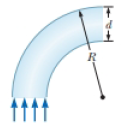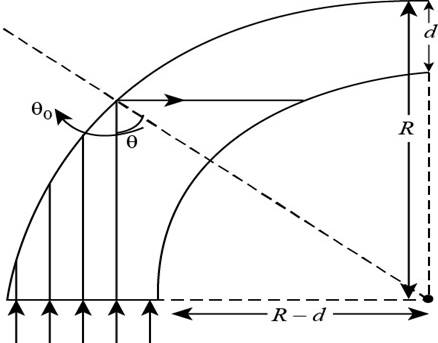
Concept explainers
An optical fiber has an index of refraction n and diameter d. It is surrounded by vacuum. Light is sent into the fiber along its axis as shown in Figure P34.31. (a) Find the smallest outside radius Rmin permitted for a bend in the fiber if no light is to escape. (b) What If? What result does part (a) predict as d approaches zero? Is this behavior reasonable? Explain. (c) As n increases? (d) As n approaches 1? (c) Evaluate Rmin assuming the fiber diameter is 100 μm and its index of refraction is 1.40.
Figure P34.31

(a)
Answer to Problem 35.49P
Explanation of Solution
Given info: The index of refraction is
The figure that represents the given conditions is shown below,

Figure (1)
From figure a ray originally moves along the inner edge will have the smallest angle of incidence when it strikes the outer edge of the fiber in the curve. Thus, if this ray is totally internally reflected, all of the others are also totally reflected.
The necessary condition for the ray to be total internal reflection is,
Here,
For very small value of
The above condition can be written as,
The expression of
Substitute 1 for the value of
The expression of
Here,
The expression of equation (1) becomes.
The minimum value of outside radius permitted for a bend in the fiber is
Conclusion:
Therefore, the smallest outside radius
(b)
Answer to Problem 35.49P
Explanation of Solution
The result from part (a) is,
Here,
The value of
The lesser value of
The thinner the optical fiber, the radius up to which the fiber is bent becomes smaller.
Conclusion:
Therefore, the
(c)
Answer to Problem 35.49P
Explanation of Solution
As
Here,
The above expression can be written as,
It is clear that as
Yes, as
Conclusion:
Therefore, the
(d)
Answer to Problem 35.49P
Explanation of Solution
As
Here,
The above expression can be written as,
It is clear that as
Yes, as
Conclusion:
Therefore, the value
(e)
Answer to Problem 35.49P
Explanation of Solution
Given info: The diameter of the fiber is
Explanation:
The formula to calculate the
Here,
Substitute
Conclusion:
Therefore, the value of
Want to see more full solutions like this?
Chapter 35 Solutions
EBK PHYSICS FOR SCIENTISTS AND ENGINEER
- How many times will the incident beam in Figure P34.33 (page 922) be reflected by each of the parallel mirrors? Figure P34.33arrow_forwardFigure P23.28 shows a curved surface separating a material with index of refraction n1 from a material with index n2. The surface forms an image I of object O. The ray shown in red passes through the surface along a radial line. Its angles of incidence and refraction are both zero, so its direction does not change at the surface. For the ray shown in blue, the direction changes according to n1 sin 1 = n2 sin 2. For paraxial rays, we assume 1 and 2 are small, so we may write n1 tan 1 n2 tan 2. The magnification is defined as M = h/h. Prove that the magnification is given by M = n1q/n2p. Figure P23.28arrow_forwardFigure P26.72 shows a thin converging lens for which the radii of curvature of its surfaces have magnitudes of 9.00 cm and 11.0 cm. The lens is in front of a concave spherical mirror with the radius of curvature R = 8.00 cm. Assume the focal points F1 and F2 of the lens are 5.00 cm from the center of the lens. (a) Determine the index of refraction of the lens material. The lens and mirror are 20.0 cm apart, and an object is placed 8.00 cm to the left of the lens. Determine (b) the position of the final image and (c) its magnification as seen by the eye in the figure. (d) Is the final image inverted or upright? Explain.arrow_forward
- The index of refraction for violet light in silica flint glassis 1.66 and that for red light is 1.62. What is the angulardispersion of visible light passing through an equilateralprism of apex angle 60.0° if the angle of incidence is 50.0°?(See Fig. P22.62.)arrow_forwardAn optical cable in air is orientated horizontally. The cable has a core and a cladding layer. The index of refraction for the core is 1.3 and the index of refraction for the cladding layer is 1.2. A light ray enters the center of the cable with an incident angle ß=58°. The ray is subsequently refracted at the core-cladding interface and the cladding-air interface. The angle between the exit ray and the cable wall is a. What is the angle a? The index of refraction of air is 1. ←cladding -corearrow_forwardIn the figure, light is incident at angle 6, = 41.0° on a boundary between two transparent materials. Some of the light travels down through the next three layers of transparent materials, while some of it reflects upward and then escapes into the air. If n1 = 1.28, n, = 1.38, ng = 1.30 and n4 = 1.43, what is the value of (a) 05 and (b) 04? Air (a) 05 = NumberT32.02 UnitsTo (degrees) (b)04 = NumberT43.1 Units (degrees)arrow_forward
- Q. 1. A ray of light incident at an angle 0 on a refracting face of a prism emerges from the other face normally. If the angle of the prism is 5° and the prism is made of a material of refractive index 1.5, the angle of incidence is : (a) 7.5° (c) 15° (b) 5° (d) 2.5°arrow_forwardAn optical fiber has an index of refraction n and diameter d. It is surrounded by vacuum. Light is sent into the fiber along its axis as shown. (a) Find the smallest outside radius Rmin permitted for a bend in the fiber if no light is to escape. (b) What If? What result does part (a) predict as d approaches zero? Is this behavior reasonable? Explain. (c) As n increases? (d) As n approaches 1? (e) Evaluate Rmin assuming the fiber diameter is 100 mm and its index of refraction is 1.40.arrow_forwardThe figure shows an optical fiber in which a central plastic core of index of refraction n1 = 1.60 is surrounded by a plastic sheath of index of refraction n2 = 1.52. Light can travel along different paths within the central core, leading to different travel times through the fiber. This causes an initially short pulse of light to spread as it travels along the fiber, resulting in information loss. Consider light that travels directly along the central axis of the fiber and light that is repeatedly reflected at the critical angle along the core-sheath interface, reflecting from side to side as it travels down the central core. If the fiber length is 370 m, what is the difference in the travel times along these two routes? NUmber i 99 Units nsarrow_forward
- Problem 6: Fiber optics are an important part of our modern internet. In these fibers, two different glasses are used to confine the light by total internal reflection at the critical angle for the interface between the core (ncore = 1.508 ) and the cladding (ncladding = 1.43). Part (a) Numerically, what is the largest angle (in degrees) a ray will make with respect to the interface of the fiber θmax, and still experience total internal reflection? Part (b) Suppose you wanted the largest angle at which total internal reflection occurred to be θmax = 5 degrees. What index of refraction does the cladding need if the core is unchanged?arrow_forwardThe figure shows an optical fiber in which a central plastic core of index of refraction n1 = 1.64 is surrounded by a plastic sheath of index of refraction n2 = 1.56. Light can travel along different paths within the central core, leading to different travel times through the fiber. This causes an initially short pulse of light to spread as it travels along the fiber, resulting in information loss. Consider light that travels directly along the central axis of the fiber and light that is repeatedly reflected at the critical angle along the core-sheath interface, reflecting from side to side as it travels down the central core. If the fiber length is 390 m, what is the difference in the travel times along these two routes? NUmber i Unitsarrow_forwardPart (b) Numerically, what is the angle in degrees? θ2= Part (c) Write an expression for the reflection angle ψ, with respect to the surface. ψ = Part (d) Numerically, what is this angle in degrees? ψ =arrow_forward
 Physics for Scientists and EngineersPhysicsISBN:9781337553278Author:Raymond A. Serway, John W. JewettPublisher:Cengage Learning
Physics for Scientists and EngineersPhysicsISBN:9781337553278Author:Raymond A. Serway, John W. JewettPublisher:Cengage Learning Physics for Scientists and Engineers with Modern ...PhysicsISBN:9781337553292Author:Raymond A. Serway, John W. JewettPublisher:Cengage Learning
Physics for Scientists and Engineers with Modern ...PhysicsISBN:9781337553292Author:Raymond A. Serway, John W. JewettPublisher:Cengage Learning Principles of Physics: A Calculus-Based TextPhysicsISBN:9781133104261Author:Raymond A. Serway, John W. JewettPublisher:Cengage Learning
Principles of Physics: A Calculus-Based TextPhysicsISBN:9781133104261Author:Raymond A. Serway, John W. JewettPublisher:Cengage Learning Physics for Scientists and Engineers: Foundations...PhysicsISBN:9781133939146Author:Katz, Debora M.Publisher:Cengage Learning
Physics for Scientists and Engineers: Foundations...PhysicsISBN:9781133939146Author:Katz, Debora M.Publisher:Cengage Learning Physics for Scientists and Engineers, Technology ...PhysicsISBN:9781305116399Author:Raymond A. Serway, John W. JewettPublisher:Cengage Learning
Physics for Scientists and Engineers, Technology ...PhysicsISBN:9781305116399Author:Raymond A. Serway, John W. JewettPublisher:Cengage Learning College PhysicsPhysicsISBN:9781305952300Author:Raymond A. Serway, Chris VuillePublisher:Cengage Learning
College PhysicsPhysicsISBN:9781305952300Author:Raymond A. Serway, Chris VuillePublisher:Cengage Learning





